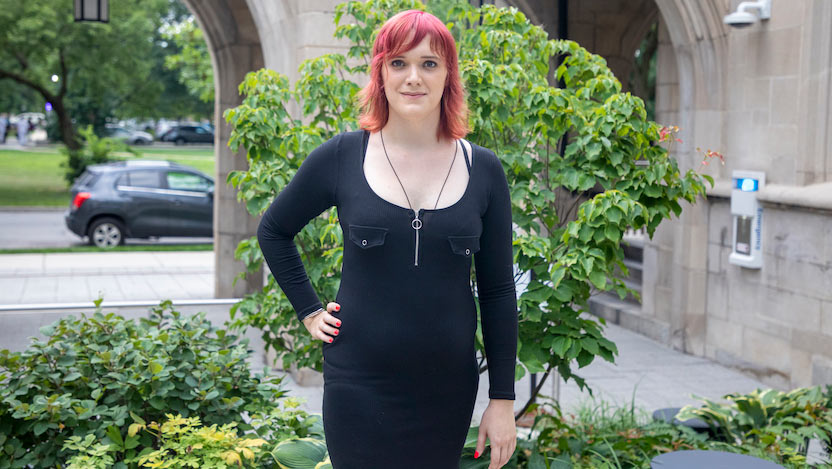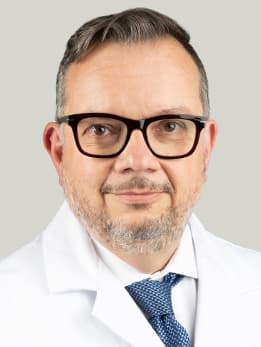Gender-affirming vaginoplasties offered at UChicago Medicine

Ervin Kocjancic, MD
Caring for transgender patients starts with intensive training and knowledge for everyone from the front desk to the operating room. Just ask Trans CARE (Clinic for Affirmation and Reproductive Equity).
Transgender people — those whose gender identity does not correspond with their sex perceived at birth — face significant hurdles in modern society. Having to contend with challenges ranging from discrimination and violence to inadequate access to healthcare, trans individuals face higher rates of depression, anxiety and suicide attempts, among other health risks.
To achieve bodily integrity (a feeling of physical wholeness and alignment between the brain and the body), many trans people receive hormone replacement therapy (HRT). For some, another vital step is undergoing gender-confirming surgery. This can include breast removal or augmentation, phalloplasty (construction of the penis and urethra), orchiectomy (removal of testes), vaginoplasty (construction of the vagina) and vulvaplasty combined with labiaplasty (construction of the vulva and labia).
Colloquially, these surgeries have other names. For example, the removal of breast tissue and the construction of a more masculine-looking chest is called top surgery. And genital reconstruction surgeries are often called bottom surgeries.
Complex procedures for unique health needs
Finding inclusive, skilled clinicians who can perform these complicated surgeries is often a significant hurdle. Vaginoplasties are particularly complex, sometimes taking more than six hours to perform. Surgeons use skin and tissue from existing genitalia to create an inner and outer labia along with a new opening for the urethra and a cavity — of varying depth — between the rectum and bladder. Patients who've had vaginoplasties are able to experience the full range of sexual pleasure, including orgasm. Those with full-depth vaginal cavities can have penetrative intercourse, while those with shallower, zero-depth cavities cannot.
"Many patients get turned away from other institutions for various reasons. They might have challenging anatomy or other risk factors. We often take those patients," said Kocjancic, who is among a small group of reconstructive urologic surgeons who perform vaginoplasties with full-depth cavities.
Using non-stigmatizing language and making people feel welcome are Kocjancic’s first priorities. He wants to consider the full scope of his patients' needs, and for them to feel seen and respected.
“We’re not just doing a surgery — we are taking care of the health of these patients,” he said. “We are actively working with them to help them. It’s a partnership.”
Many patients get turned away from other institutions for various reasons. They might have challenging anatomy or other risk factors. We often take those patients.
Gender-affirming interventions do more than help people combat gender dysphoria. A recent JAMA Network Open study showed trans and nonbinary people who received gender-affirming interventions like puberty blockers and hormones had 60% lower odds of having moderate-to-severe depressive symptoms and 73% lower odds of self-harming or having suicidal thoughts during the first year of their multidisciplinary gender care.
Still, many trans individuals spend years struggling to find healthcare providers who are knowledgeable about their needs.
“Add in financial barriers, discrimination, lack of cultural competence by providers and socioeconomic barriers, and you’ve just begun to comprehend how difficult it can be for people to receive adequate treatment — whether it’s for basic or more complex health needs,” said Kocjancic.
Finding an inclusive provider

Tiegann Rogue, 38, was perceived male at birth and first came out as a trans woman in her early 20s. Unable to begin estrogen therapy to develop a more feminine appearance, she became increasingly distressed by her body.
“It was a struggle because (in school) we always had conversations where professionalism and professional appearances came up,” Rogue said. “And I struggled with that idea since I was presenting as female, but still hadn’t begun hormone therapy.”
Frustrated and lost, Rogue cut her hair, threw away all of her clothes and bought an entire new wardrobe to resume presenting as a male-bodied individual.
“I figured I was always going to have to live up to other people’s standards and never get to live as myself,” she said. “It was a very miserable, very dark time, for quite a long time.”
A decade later, with the support of her partner and the freedom of more-inclusive medical and legal standards for HRT, Rogue began taking estrogen. Then she began to look for gender affirmation surgery so her body would appear more feminine in public.
Rogue was initially turned away by six surgeons, all of whom had an upper threshold for body mass index (BMI) that she exceeded. (Patients with high BMIs are at higher risks for infections and other complications with surgery.)
The whole thing gave me a complete new lease on life, I feel so comfortable in my body.
Through a web search, Rogue eventually found Kocjancic, who performed her vaginoplasty surgery in April 2022.
“The whole thing gave me a complete new lease on life,” she said. “I feel so comfortable in my body. Even though I went through a horrible first experience, and I transitioned, and I lived in the wrong body for an additional 10 years, all of it was worth it to get to this feeling, to get to this point of being. In light of all the complications and risks of being a high BMI patient, I had zero complications and no issues with infection, and I am healing exceedingly well.”
Leveraging robotic-assisted technology

For Jenji Learn, 34, her journey provided a host of other challenges and complications.
A loquacious trans woman who grew up in rural Virginia and moved to Chicago at 25, Learn was conscious of her gender identity at an early age.
She began taking feminizing hormones in high school, but was unable to begin searching for gender affirmation surgery until after graduate school.
But Learn's medical history — which put her at increased odds for surgical complications — made an already arduous task more challenging. In addition to inflammatory bowel disease (IBD), she had extreme varicose and collapsed blood vessels in one of her testes. The collapse was due to a congenital malformation, or an underlying structural flaw. She desperately sought out urological surgeons, no less than four, who refused to remove her defective testicle. Instead, she was forced to have another procedure that left her with nerve damage and chronic pain.
Learn then also sought out surgeons across the Midwest but struggled to find someone who would perform gender confirmation surgery.
“I remember crying in the office of one Wisconsin doctor who would only do a zero-depth surgery, if at all,” she said. “It was like she didn’t understand the severity of what she was saying to me at all. Bodily integrity is an intrinsic good and an intrinsic part of our health. And denying that to someone is incredibly cruel.”
When Learn found Kocjancic, she was thrilled to learn he offered a robotic-assisted technique that would help mitigate infection and other risk factors.
Learn was surprised when Kocjancic insisted on seeing her for two in-office appointments before her procedure. She was afraid he would say something about her risk factors or further delay the operation, since a second pre-surgical consultation was not required by the standards of care. She soon learned it was Kocjancic's personal patient policy.
It meant the world to me to know that he actually cared and saw me as a human being and understood the value of what he was doing.
“He called me and said, ‘No, no, don't worry — it's nothing like that. It's just that you're a new patient to me, and I don't like to operate on someone I have met only once before I see them in the OR. It feels so impersonal.’”
“That about knocked me over, because it was just so far removed from everything I had experienced up to that point,” Learn said. “It meant the world to me to know that he actually cared and saw me as a human being and understood the value of what he was doing.”
“Dr. Kocjancic allowed me to choose whether I wanted him to take a more minimalist or maximalist approach about achieving depth, and we agreed to come at it from the stand point that he would try to achieve as much depth as he safely could in the initial procedure, but I went in fully aware that if there were any problems during the procedure or complications afterwards, then I would probably have to give up at least a little of that depth to make sure things could heal safely, and that's exactly what ended up happening. But when it did, neither one of us was surprised, and I had no reason to be frustrated because he respected my wishes and, while always confident in his abilities, gave me a very realistic picture of what the limitations are and what to expect, so were always on the same page,” she said.
There was a series of complications as Learn recovered: She had a fistula, or abnormal hollow passage, that formed in her bladder and caused incontinence. Not being able to dilate from the fistula led to stenosis of the vagina, which caused her new vaginal cavity to lose depth. Kocjancic repaired them during seven follow-up procedures, which were aided by Learn’s ability to stay committed to dilations and physical therapy to help recovery abdominal and pelvic floor strength. The entire process took over a year.
Now, Learn is doing well, and despite the complications and additional challenges, she has no regrets.
"There’s literally not a day that I wake up that I just don't feel so profoundly grateful and such a tremendous sense of relief,” she said. “One of the gifts of being trans is there's never a single second that I take it for granted.”

Ervin Kocjancic, MD
Ervin Kocjancic, MD, is a skilled reconstructive urologist who specializes in pelvic health, urinary incontinence, and reconstructive surgery for female, male and transgender patients with an expertise in gender affirmation surgery and complex reconstructive genitourinary conditions.
View Dr. Kocjancic's physician bio